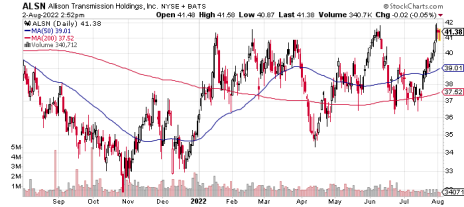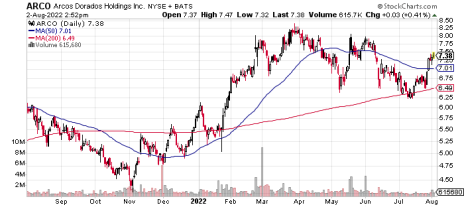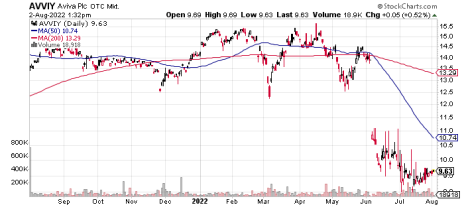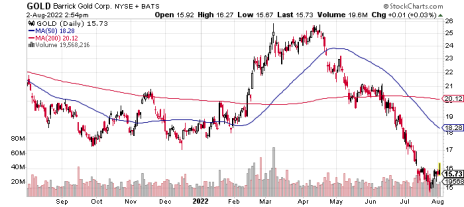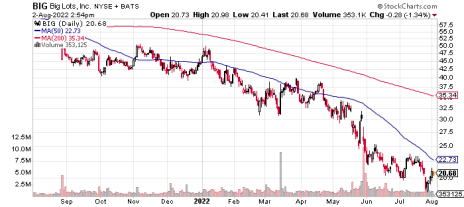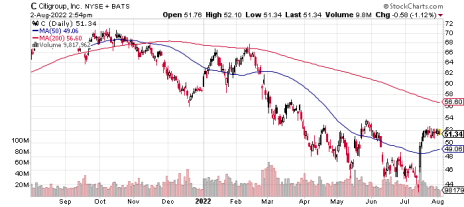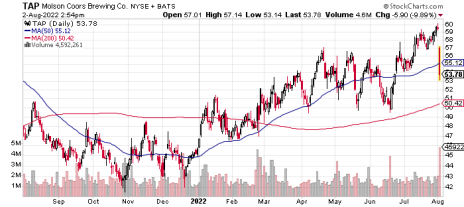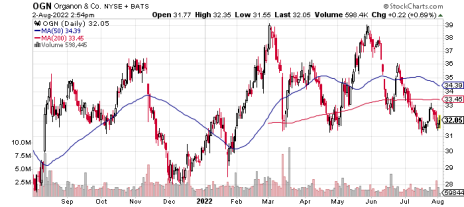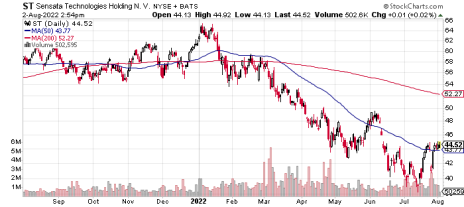Thank you for subscribing to the Cabot Undervalued Stocks Advisor. We hope you enjoy reading the August 2022 issue.
Ernest Hemingway’s quote about “… gradually then suddenly…” could apply to the escalating geopolitical tensions.
It has been a quiet month for new recommendations and ratings changes as we patiently wait for attractive opportunities in a difficult investing climate.
Please feel free to send me your questions and comments. This newsletter is written for you and the best way to get more out of the letter is to let me know what you are looking for.
I’m best reachable at Bruce@CabotWealth.com. I’ll do my best to respond as quickly as possible.
Thanks!
Cabot Undervalued Stocks Advisor Issue: August 3, 2022
DOWNLOAD ISSUE PDFSlowly, Then Suddenly?
Ernest Hemingway wrote in his classic 1926 novel, The Sun Also Rises, this timeless quote:
“How did you go bankrupt?” Bill asked.
“Two ways,” Mike said. “Gradually and then suddenly.”
What Hemingway couldn’t know was that he also may have been talking about how the world’s geopolitical situation has changed in the past few months. Since the start of the year, Russia invaded Ukraine and now China is poised to conduct live-fire military drills in six zones that would encircle Taiwan.
This is purely an investment advisory, so we will set aside the potentially immense human tragedy if the situation deteriorates.
One possible side effect of a Chinese conflict in Taiwan is that Intel (INTC), Global Foundries (GFS) and other semiconductor companies could double or more in value. With Taiwanese fabs offline, the Western fabs would be scarce yet much-needed assets. Makers of chip equipment like Applied Materials (AMAT) may see little increase in value as their biggest customer would no longer be a buyer, although new orders for new Western fabs would certainly surge.
There would be sanctions and a wide range of other side effects, but these are murkier to predict given the scale of economic integration between the Western world and China.
It all seems to be moving gradually, and then suddenly.
Share prices in the table reflect Tuesday (August 2) closing prices. Please note that prices in the discussion below are based on mid-day August 2 prices.
Note to new subscribers: You can find additional color on past earnings reports and other news on recommended companies in prior editions and weekly updates of the Cabot Undervalued Stocks Advisor on the Cabot website.
Send questions and comments to Bruce@CabotWealth.com.
Today’s Portfolio Changes
None.
Portfolio changes during the past month
None.
Upcoming earnings reports
Wednesday, August 3: Allison Transmission Holdings (ALSN)
Thursday, August 4: Organon (OGN)
Monday, August 8: Barrick Gold (GOLD)
Wednesday, August 10: Aviva plc (AVVIY), Arcos Dorados (ARCO)
Wednesday, August 17: Cisco Systems (CSCO)
A
Growth & Income
Portfolio
Growth & Income Portfolio stocks are generally higher-quality, larger-cap companies that have fallen out of favor. They usually have some combination of attractive earnings growth and an above-average dividend yield. Risk levels tend to be relatively moderate, with reasonable debt levels and modest share valuations.
| Stock (Symbol) | Date Added | Price Added | 8/2/22 | Capital Gain/Loss | Current Dividend Yield | Price Target | Rating |
| Cisco Systems (CSCO) | 11-18-20 | 41.32 | 45.19 | 9.4% | 3.4% | 66.00 | Buy |
| Coca-Cola (KO) | 11-11-20 | 53.58 | 63.60 | 18.7% | 2.6% | 69.00 | Hold |
| Dow Inc (DOW) * | 04-01-19 | 53.50 | 52.09 | -2.6% | 5.4% | 78.00 | Buy |
| Merck (MRK) | 12-9-20 | 83.47 | 88.37 | 5.9% | 3.1% | 99.00 | Hold |
| Current price | Current 2022 EPS Estimate | Current 2023 EPS Estimate | Change in 2022 Estimate | Change in 2023 Estimate | P/E 2022 | P/E 2023 | |
| CSCO | 45.31 | 3.36 | 3.54 | 0.0% | 0.0% | 13.5 | 12.8 |
| KO | 64.06 | 2.46 | 2.62 | 0.0% | -0.4% | 26.0 | 24.5 |
| DOW | 52.46 | 8.01 | 6.67 | 0.0% | -0.3% | 6.5 | 7.9 |
| MRK | 88.73 | 7.37 | 7.45 | -0.1% | 0.3% | 12.0 | 11.9 |
Cisco Systems (CSCO) is facing revenue pressure as customers migrate to the cloud and thus need less of Cisco’s equipment and one-stop-shop services. Cisco’s prospects are starting to improve under a relatively new CEO, who is shifting Cisco toward a software and subscription model and is rolling out new products, helped by its strong reputation and entrenched position within its customers’ infrastructure. The company is highly profitable, generates vast cash flow (which it returns to shareholders through dividends and buybacks) and has a very strong balance sheet.
While Cisco shares’ round-trip from our initial recommendation at 41.32 to 64 and back to around 45 is frustrating, this is not the time to sell the stock. The fundamentals remain reasonably stable and likely to tick back upward, and profits seem likely to improve, as well. The shares will likely come back to life as earnings reports show favorable growth and profit trends, so investors will need some patience. If we have a recession in global tech spending, Cisco would likely feel the downturn but not as severely as other technology companies due to the mission-critical nature of its products and services.
There was no significant company-specific news in the past week.
CSCO shares rose 3% in the past week and have 46% upside to our 66 price target. The valuation is attractive at 9.2x EV/EBITDA and 13.5x earnings, the shares pay a sustainable 3.4% dividend yield, the balance sheet is very strong and Cisco holds a key role in the basic plumbing of technology systems even if its growth rate is only modest. BUY
The Coca-Cola Company (KO) is best known for its iconic soft drinks yet nearly 40% of its revenues come from non-soda beverages across the non-alcoholic spectrum. Its global distribution system reaches nearly every human on the planet. Coca-Cola’s longer-term picture looks bright but the shares remain undervalued due to concerns over the pandemic, the secular trend away from sugary sodas, and a tax dispute which could cost as much as $12 billion (likely worst-case scenario). The CEO James Quincey (since 2017) is reinvigorating the company by narrowing its over-sized brand portfolio, boosting its innovation and improving its efficiency, as well as improving its health and environmental image. Coca-Cola’s balance sheet is sturdy, and its growth investing, debt service and dividend are well-covered by free cash flow.
On July 26, Coca-Cola reported a solid quarter – a “beat and raise” in Street parlance. Revenues rose 12% and were about 7% above the consensus estimate. Comparable earnings of $0.70/share rose 4% from a year ago and were 4% above the consensus estimate. The company raised its full-year organic revenue growth guidance to +12-13% from +7-8%, as it sees continued strength in demand and pricing. Coke also raised its guidance for comparable currency-neutral earnings per share growth to +14-15% from +8-10% due to the higher revenues.
The company is participating in the global post-pandemic recovery as consumers shift to out-of-home activities including travel, while also being able to raise its prices to help offset cost inflation.
Organic revenue growth (which excludes the effects of currency changes and acquisitions/divestitures) was a healthy 16%. Revenues were strong across nearly all product groups and geographies. Higher pricing and more sales of higher-priced products contributed 12% to revenue growth, while volumes added 4%. Overall, Coca-Cola is seeing a good recovery around the world and has been able to raise prices without scaring away much demand.
Operating profits, when adjusted for currency changes and acquisitions/divestitures, rose 15%. However, the margin shrank by one percentage point due to the effects of acquiring lower-margin BodyArmor, higher operating costs and higher marketing costs as Coke continues to spend on its brand building. Currency changes also weighed on margins. Free cash flow and the balance sheet remained sturdy.
There was no significant company-specific news in the past week.
KO shares rose 1% in the past week and have 8% upside to our 69 price target. Coca-Cola’s fundamentals remain sturdy with respectable revenue, profit and free cash flow growth. Management continues to focus on execution in its core business while generally avoiding any major non-core commitments. HOLD
Dow Inc. (DOW) merged with DuPont to create DowDuPont, then split into three companies in 2019 based on product type. The new Dow is the world’s largest producer of ethylene/polyethylene, the most widely used plastics. Investors undervalue Dow’s hefty cash flows and sturdy balance sheet largely due to its uninspiring secular growth traits, its cyclicality and concern that management will squander its resources. The shares are driven by: 1) commodity plastics prices, which are often correlated with oil prices and global growth, along with competitors’ production volumes; 2) volume sold, largely driven by global economic conditions, and 3) ongoing efficiency improvements (a never-ending quest of all commodity companies). We see Dow as having more years of strong profits before capacity increases signal a cyclical peak, and expect the company to continue its strong dividend, reduce its pension and debt obligations, repurchase shares slowly and restrain its capital spending.
On July 21, Dow reported good second-quarter and third-quarter guidance that was basically in line. But the macro environment (pricing and costs) is shifting from a tailwind to neutral/negative and investors worry about a domestic and global recession, so the shares may remain out of favor. However, the company is likely to remain highly-profitable, in a strong competitive position, with an underleveraged balance sheet. The quarterly dividend provides a 5.5% yield, and the shares trade at a low 4.5x EV/EBITDA multiple. Barring a deep recession, collapse in oil prices or a surge in supply, Dow’s fundamental earnings picture seems solid.
Revenues rose 13% and were fractionally ahead of the consensus estimate. Operating earnings of $2.31/share fell 15% from a year ago but were 8% above estimates. Operating EBITDA of $3.1 billion fell 14% from a year ago but was about 5% above estimates.
Volumes were flat compared to a year ago – essentially in line with the prior several quarters where volumes fluctuated around zero. The driver of Dow’s revenue growth and huge profits are the sharply higher prices it receives. In the second quarter, local price (excludes currency translations into the U.S. dollar) rose 16%. This is a hefty price increase, but this pace has decelerated from +39% in the fourth quarter and +28% in the first quarter of this year, suggesting that the company’s ability to raise prices may be reaching a limit.
Profits fell primarily due to rapidly increasing raw material and energy costs, and to a lesser extent due to lower profits in its joint ventures and lower volumes due to planned downtime for maintenance at some of its facilities. It appears that rising costs are eclipsing Dow’s ability to raise its prices. Dow has a global customer base across its three primary segments, so each region and segment has its variances, but these variances generally point in the same direction and when aggregated paint a reasonably consistent story.
Free cash flow remains robust at $1.4 billion, which mostly went toward share repurchases and dividends. The balance sheet is sturdy with no major maturities until 2027, and Dow paid off $750 million in notes. A favorable side effect of rising interest rates is that Dow’s pension obligations have a lower present value. This could slash its previously-large $6 billion net pension liability to nearly zero by year-end, for an $8.50/share positive swing in value.
There was no significant company-specific news in the past week.
Dow shares rose 2% in the past week as recession fears increased. The shares have 49% upside to our 78 price target and offer an attractive and what appears to be sustainable 5.3% dividend yield. BUY
Merck (MRK) shares are undervalued as investors worry about Keytruda, a blockbuster oncology treatment (about 30% of revenues) which faces generic competition in late 2028. Also, its Januvia diabetes treatment may see generic competition next year, and like all pharmaceuticals it is at-risk from possible government price controls. Yet, Keytruda is an impressive franchise that is growing at a 20% rate and will produce solid cash flow for nearly six more years, providing the company with considerable time to replace the potential revenue loss. Merck’s new CEO, previously the CFO, is accelerating Merck’s acquisition program, which adds return potential and risks to the story. The company is highly profitable and has a solid balance sheet. It spun off its Organon business in June 2021 and we think it will divest its animal health segment sometime in the next five years.
Merck reported a solid quarter and maintained its full-year 2022 guidance, but didn’t comment on rumors of a possible acquisition of Seagen. We believe Merck will be an active buyer of treatments and companies to fill the lost revenues as Keytruda loses its patent protection in 2028.
Revenues rose 28% from a year ago and were about 5% above estimates. Excluding Lagevrio, which is the trade name for Merck’s mulnupiravir Covid treatment, sales grew 18%. Adjusted earnings of $1.87/share were triple the year-ago earnings and were 10% above estimates. The company incrementally raised its full year revenue guidance but this appears to be due entirely to currency changes. The earnings guidance range was narrowed but the midpoint of $7.30/share was unchanged. While the changes seem uninspiring at the margin, the guidance calls for an impressive 18-20% revenue growth and 36% earnings growth.
Keytruda sales rose 30% excluding currency changes, reflecting the growing relevance of this treatment, a positive in advance of the arrival of generic competition in 2028. Volumes will likely remain strong even if pricing slides under broad competition. Relevance also suggests that the treatment has a higher likelihood of receiving protection from competition through new formulations changes.
Sales of Gardasil, the treatment for human pampillomavirus, rebounded 30%. Investors had sold down Merck shares during the pandemic partly due to the fall-off in demand for Gardasil, but in hindsight sales fell as patients halted visits to their doctors.
Sales in the Animal Health unit rose 5% excluding currency changes.
The overall gross margin slipped due to lower Lagevrio margins along with higher inventory write-offs and manufacturing costs. Operating costs fell about 21% but most of this was due a one-time $1.7 billion change a year ago. Excluding the effect of this charge, expenses rose 7%.
As is its custom, Merck didn’t provide cash flow or balance sheet information with the report, so we will wait for the 10Q. Merch remains behind current practice in this regard.
The consensus earnings estimate of $7.37 for 2022 is seven cents above the company’s guidance. We expect the company to beat this full-year estimate.
Merck shares slipped 3% in the past week and have about 12% upside to our 99 price target. The company has a strong commitment to its dividend (3.1% yield) which it backs up with generous free cash flow, although its shift to a more acquisition-driven strategy will slow the pace of dividend increases. While the shares have pulled back, we are retaining our Hold rating as rising interest rates reduce the upside potential value of its shares. HOLD
Buy Low Opportunities
Portfolio
Buy Low Opportunities Portfolio stocks include a wide range of value opportunities, often with considerable upside. This group may include stocks across the quality and market cap spectrum, including those with relatively high levels of debt and a less-clear earnings outlook. The stocks may not pay a dividend. In all cases, the shares will trade at meaningful discounts to our estimate of fair value.
| Stock (Symbol) | Date Added | Price Added | 8/2/22 | Capital Gain/Loss | Current Dividend Yield | Price Target | Rating |
| Allison Transmission Hldgs (ALSN) | 02-22-22 | 39.99 | 41.35 | 3.4% | 2.0% | 48.00 | Buy |
| Arcos Dorados (ARCO) | 04-28-21 | 5.41 | 7.38 | 36.4% | 2.2% | 8.50 | Buy |
| Aviva (AVVIY) | 03-03-21 | 10.75 | 9.63 | -10.4% | 5.8% | 14.00 | Buy |
| Barrick Gold (GOLD) | 03-17-21 | 21.13 | 15.71 | -25.7% | 2.5% | 27.00 | Buy |
| BigLots (BIG) | 04-12-22 | 35.24 | 20.62 | -41.5% | 5.8% | 35.00 | Hold |
| Citigroup (C) | 11-23-21 | 68.10 | 51.45 | -24.4% | 4.0% | 85.00 | Buy |
| Molson Coors (TAP) | 08-05-20 | 36.53 | 53.85 | 47.4% | 2.8% | 69.00 | Buy |
| Organon (OGN) | 06-07-21 | 31.42 | 32.15 | 2.3% | 3.5% | 46.00 | Buy |
| Sensata Technologies (ST) | 02-17-21 | 58.57 | 44.66 | -23.7% | 1.0% | 75.00 | Buy |
| Current price | Current 2022 EPS Estimate | Current 2023 EPS Estimate | Change in 2022 Estimate | Change in 2023 Estimate | P/E 2022 | P/E 2023 | |
| ALSN | 41.20 | 6.24 | 7.05 | 0.0% | 0.0% | 6.6 | 5.8 |
| ARCO | 7.39 | 0.51 | 0.55 | 0.0% | 5.8% | 14.5 | 13.4 |
| AVVIY | 9.67 | 1.01 | 1.27 | -2.3% | -1.9% | 9.6 | 7.6 |
| GOLD | 16.00 | 1.00 | 1.07 | 0.0% | 0.0% | 16.0 | 14.9 |
| BIG | 20.50 | (2.43) | 2.26 | 0.0% | 0.0% | (8.4) | 9.1 |
| C | 51.85 | 7.27 | 6.94 | -1.5% | -2.9% | 7.1 | 7.5 |
| TAP | 53.78 | 4.00 | 4.28 | 1.5% | 0.2% | 13.4 | 12.6 |
| OGN | 32.05 | 5.12 | 5.55 | -2.7% | -1.6% | 6.3 | 5.8 |
| ST | 44.43 | 3.40 | 4.00 | -7.4% | -8.0% | 13.1 | 11.1 |
Current price is yesterday’s mid-day price.
Allison Transmission Holdings, Inc. (ALSN) – Allison Transmission is a mid-cap ($6.4 billion market cap) manufacturer of vehicle transmissions. Many investors view this company as a low-margin producer of car and light truck transmissions that is destined for obscurity in an electric vehicle world. However, Allison produces no car and light truck transmissions, instead it focuses on the school bus and Class 6-8 heavy-duty truck categories, where it holds an 80% market share. Its 35% EBITDA margin is sharply higher than its competitors and on par with many specialty manufacturers. And, it is a leading producer and innovator in electric axles which all electric trucks will require. Another indicator of its advanced capabilities: Allison was selected to help design the U.S. Army’s next-generation electric-powered vehicle. The company generates considerable free cash flow and has a low-debt balance sheet. Its capable leadership team keeps its shareholders in mind, as the company has reduced its share count by 38% in the past five years.
Allison is expected to report earnings of $1.57/share today (August 3).
Allison shares rose 4% in the past week and have 17% upside to our 48 price target. The stock pays an attractive and sustainable 2.0% dividend yield to help compensate for the wait. BUY
Arcos Dorados (ARCO), which is Spanish for “golden arches,” is the world’s largest independent McDonald’s franchisee. Based in stable Uruguay and listed on the NYSE, the company produces about 72% of its revenues in Brazil, Mexico, Argentina and Chile. The shares are depressed as investors worry about the pandemic, as well as political/social unrest, inflation and currency devaluations. However, the company has a solid brand and high recurring demand and is well-positioned to benefit as local economies re-open. The leadership looks highly capable, led by the founder/chairman who owns a 38% stake, and has the experience to successfully navigate the complex local conditions. Debt is reasonable relative to post-recovery earnings, and the company is currently producing positive free cash flow.
Macro issues, including issues in Brazil related to its economic conditions (in particular, inflation, running at an 11.7% rate), currency and the chances that a socialist might win this year’s Brazilian presidential elections, will continue to influence ARCO shares.
Arcos is expected to report adjusted earnings of $0.14/share next week.
ARCO shares rose 14% in the past week and have 15% upside to our 8.50 price target. BUY
Aviva, plc (AVVIY), based in London, is a major European company specializing in life insurance, savings and investment management products. Amanda Blanc was hired as the new CEO in July 2020 to revitalize Aviva’s laggard prospects. She divested operations around the world to re-focus the company on its core geographic markets (U.K., Ireland, Canada), and is improving Aviva’s product competitiveness, rebuilding its financial strength and trimming its bloated costs. Aviva’s dividend has been reduced to a more predictable and sustainable level with a modest upward trajectory. Excess cash balances are being directed toward debt reduction and potentially sizeable special dividends and share repurchases.
Much of our interest in Aviva is based on its plans for returning its excess capital to shareholders, including share repurchases and dividends. These distributions could be substantial. We also look for incremental shareholder-friendly pressure from highly regarded European activist investor Cevian Capital, which holds a 5.2% stake.
Aviva is expected to report first-half 2022 earnings of £0.17/share, or about $0.41/ADR, next week.
There was no significant company-specific news in the past week. Please note that the ticker symbol for the ADS has reverted back to “AVVIY” following their overly-complicated share buyback transaction.
Aviva shares rose 3% in the past week and have about 45% upside to our 14 price target. Based on management’s estimated dividend for 2023 (which we believe is highly credible), the shares produce a generous 8.6% yield. Based on this year’s actual dividend, the shares offer an attractive 5.8% dividend yield. BUY
Barrick Gold (GOLD), based in Toronto, is one of the world’s largest and highest quality gold mining companies. About 50% of its production comes from North America, with the balance from Africa/Middle East (32%) and Latin America/Asia Pacific (18%). Barrick will continue to improve its operating performance (led by its new and highly capable CEO), generate strong free cash flow at current gold prices, and return much of that free cash flow to investors while making minor but sensible acquisitions. Also, Barrick shares offer optionality – if the unusual economic and fiscal conditions drive up the price of gold, Barrick’s shares will rise with it. Given their attractive valuation, the shares don’t need this second (optionality) point to work – it offers extra upside. Barrick’s balance sheet has nearly zero debt net of cash. Major risks include the possibility of a decline in gold prices, production problems at its mines, a major acquisition and/or an expropriation of one or more of its mines.
On July 14, Barrick reported preliminary second-quarter unit volumes. Full results will be reported on August 8. In the preliminary report, the company said it produced 1.04 million ounces of gold and 120 million pounds of copper. It also said that it remains on track to meet its full year gold and copper guidance. For long-term investors, the company’s ability to set healthy guidance numbers and then meet/exceed them is critical, as it indicates a predictable and controllable operating process and generally high quality mines.
The company is expected to report second quarter earnings of $0.22/share next week.
Over the past week, commodity gold jumped over 4% to $1,795/ounce, bringing its price back to about break-even year-to-date. The 10-year Treasury yield tumbled to 2.62% as investors worried more about a recession and tensions between the US and China over Taiwan.
The U.S. Dollar Index, another driver of gold prices (the dollar and gold usually move in opposite directions), slipped about 1.5% to 105.70. The dollar remains strong but we attribute the mild weakness to perceptions that the Fed will ease up on its aggressive interest rate tightening campaign.
Barrick shares reversed their slide, rising 5% in the past week. Earnings estimates are ticking down to follow gold prices. The shares have about 69% upside to our 27 price target. The price target is based on 7.5x estimated steady-state EBITDA and a modest premium to our estimate of $25/share of net asset value. BUY
Big Lots (BIG) – Big Lots is a discount general merchandise retailer based in Columbus, Ohio, with 1,431 stores across 47 states. Its stores offer an assortment of furniture, hard and soft home goods, apparel, electronics, food and consumables as well as seasonal merchandise. Our bullish case for Big Lots rests with its loyal and growing base of 22 million rewards members, its appeal to bargain-seeking customers, the relatively stable (albeit low) 5.5% cash operating profit margin, its positive free cash flow, debt-free balance sheet and low share valuation at 3.1x EV/EBITDA and 7.3x per-share earnings based on conservative January 2023 estimates.
Our thesis was deeply rattled by the company’s dismal first quarter results. Offloading its bloated inventory will require sharp discounts, which will weigh on profits while the $271 million in new borrowing ramps up the risk. We are retaining our HOLD rating for now: investor expectations are sufficiently depressed to provide some downside cushion, while management should be able to extract itself from the worst of the inventory problem over the next few quarters. Nevertheless, the Big Lots investment is now high-risk due to the new debt balance, the lost value from the inventory glut and the likelihood of a suspension of the dividend.
For now, we are holding onto Big Lot shares, likely through their upcoming earnings report which should be released on Friday, August 26. Investors have exceptionally low expectations for Big Lots and for most of the retail industry. Any less negative earnings news could lead to a sharp rally in the shares. Yet, a dour report and guidance/outlook could lead to a step-function decline in the stock price.
Big Lots shares rose 10% this past week. The shares have 71% upside to our recently reduced 35 price target. We would consider the dividend to be unsustainable and caution that investors should not count on any dividends from Big Lots. HOLD
Citigroup (C) – Citi is one of the world’s largest banks, with over $2.4 trillion in assets. The bank’s weak compliance and risk-management culture led to Citi’s disastrous and humiliating experience in the 2009 global financial crisis, which required an enormous government bailout. The successor CEO, Michael Corbat, navigated the bank through the post-crisis period to a position of reasonable stability. Unfinished, though, is the project to restore Citi to a highly-profitable banking company, which is the task of new CEO Jane Fraser.
On July 15, Citigroup reported encouraging second-quarter results. Revenues rose 11% and were about 7% above the consensus estimate. Earnings of $2.30/share fell 19% and were about 39% above the consensus estimate. The company maintained its full-year revenue and expense guidance. Overall, a good report, particularly compared to the dour investor sentiment.
Revenues were boosted by 33% growth in Trade & Treasury Solutions, a crown jewel of the bank which represents 15% of total revenues. Fixed income trading revenues (about 20% of total revenues) jumped 31% as the bank took advantage of investor uncertainty over the direction of inflation and interest rates. Credit card revenues rose 10% due to higher interest rates on higher balances. As expected, investment banking revenues fell sharply (-46%) as deal volumes shrank.
Total loans fell 2% from a year ago while deposits rose 1%. Citi’s loan/deposit ratio, a simple metric that evaluates the bank’s capacity to make loans, is at about 50%, suggesting that the bank could readily fund faster loan growth. The net interest margin expanded to 2.24%, indicating a wider level of profits on its lending compared to the 1.97% margin a year ago.
Credit quality remains sturdy as credit losses fell 36% from a year ago. The bank’s CET1 capital level rose to 11.9% from 11.8% a year ago despite sizeable dividends and share repurchases. This capital is supported by loan loss reserves that are a generous 2.4% of funded loans.
This past week, the yield spread between the 90-day T-bill and the 10-year Treasury note, which approximates the drivers behind Citi’s net interest margin, narrowed by 12 basis points to 0.19% as the long-bond yield fell. There are 100 basis points in one percent.
A recession would likely increase Citi’s credit losses, a flatter yield curve would weigh on its net interest margin, and weaker capital markets would mean fewer investment banking revenues.
There was no significant company-specific news in the past week.
Citi shares trade at 65% of tangible book value. This immense discount, which assumes a dim future for Citi, appears to be misplaced.
Citi shares rose 1% in the past week and about 64% upside to our 85 price target. Citigroup investors enjoy a 3.9% dividend yield and perhaps another 3% or more in annual accretion from the bank’s share repurchase program once it reaches its new target capital ratio and if a slowing/stalling economy doesn’t meaningfully increase its credit costs. BUY
Molson Coors Beverage Company (TAP) is one of the world’s largest beverage companies, producing the highly recognized Coors, Molson, Miller and Blue Moon brands as well as numerous local, craft and specialty beers. About two-thirds of its revenues come from the United States, where it holds a 24% market share. Investors worry about Molson Coors’ lack of revenue growth due to its relatively limited offerings of fast-growing hard seltzers and other trendier beverages. Our thesis for this company is straightforward – a reasonably stable company whose shares sell at an overly-discounted price. Its revenues are resilient, it produces generous cash flow and is reducing its debt. A new CEO is helping improve its operating efficiency and expand carefully into more growthier products. The company recently reinstated its dividend.
The company reported in-line earnings results and guidance on Tuesday, but the shares tumbled about 10% in mid-day trading as investors worried that slowing industry volumes, and perhaps that Molson’s push into premium brands has come at the wrong moment as consumers start to trade down. The decline in the share price does not diminish our appetite for the stock.
Revenues rose 2.2% excluding currency changes and in-line with estimates. Adjusted earnings of $1.19/share fell 25% yet were also in line with estimates. Non-GAAP underlying EBITDA of $566 million fell 18% from a year ago and was about 5% weaker than estimates. The company re-affirmed its full year revenue, profit and free cash flow guidance.
In the quarter, prices rose 7% but volumes fell 5%. Brand volume, which excludes volumes that Molson produces for third-party beers, fell only 2%, indicating some reasonably resilience of in-house brands relative to others. Volumes for the industry as a whole were weak in the second quarter, so it appears that Molson is gaining share. The company said that it is roughly balanced between premium brands and lower-priced brands – a mix that is more sensible today as many consumers are trading down due to inflation and the weak economy.
Profits slipped due to sharply higher materials, transportation and energy costs, as cost of goods sold in aggregate rose nearly 12% despite the flattish revenues. Marketing costs rose 7.5%, a high number but not a total surprise as management has highlighted its interest in spending to promote its new brands. The decline in underlying EBITDA in the U.S. was 20%, while the decline elsewhere was 23%.
TAP shares slipped 7% in the past week, entirely due to Tuesday’s weakness, and have about 28% upside to our 69 price target. The stock remains cheap, particularly on an EV/EBITDA basis, or enterprise value/cash operating profits, where it trades at 9.0x estimated 2022 results, still among the lowest valuations in the consumer staples group and below other brewing companies. The 2.8% dividend yield only adds to the appeal. BUY
Organon & Company (OGN) was recently spun off from Merck. It specializes in patented women’s healthcare products and biosimilars, and also has a portfolio of mostly off-patent treatments. Organon will produce better internal growth with some boost through smart yet modest-sized acquisitions. It may eventually divest its Established Brands segment. The management and board appear capable, the company produces robust free cash flow, has modestly elevated debt and will pay a reasonable dividend. Investors have ignored the company, but we believe that Organon will produce at least stable and large free cash flows with a reasonable potential for growth. At our initial recommendation, the stock traded at a highly attractive 4x earnings.
The company is expected to report earnings of $1.19/share, which is 6% below the consensus estimate a week ago. Organon is still early in its turnaround as we wait for tangible evidence that the fundamentals are moving in the right direction.
OGN shares fell 3% in the past week and have about 44% upside to our 46 price target (using the same target as the Cabot Turnaround Letter). The shares continue to trade at a remarkably low valuation while offering an attractive 3.5% dividend yield. BUY
Sensata Technologies (ST) is a $3.8 billion (revenues) producer of nearly 47,000 highly engineered sensors used by automotive (60% of revenues), heavy vehicle, industrial and aerospace customers. About two-thirds of its revenues are generated outside of the United States, with China producing about 21%. Investors undervalue Sensata’s durable franchise. Its sensors are typically critical components that generally produce high profit margins. As the sensors’ reliability is vital to safely and performance, customers are reluctant to switch to another supplier that may have lower prices but also lower or unproven quality. Sensata has an arguably under-leveraged balance sheet and generates healthy free cash flow. The relatively new CEO will likely continue to expand the company’s growth potential through acquisitions. Electric vehicles are an opportunity as they expand Sensata’s reachable market.
On July 26, Sensata reported a reasonably good quarter but reduced its guidance for the full year.
Revenues rose 2.8%, to a quarterly record, although this was partly driven by acquisitions. On an organic basis, which excludes the effects of currency changes and acquisitions/divestitures, revenues rose 2.2%. Revenues were about 2% above estimates. Adjusted earnings of $0.83/share fell 13% from a year ago but were in line with estimates. Revenues and earnings were toward the high end of the company’s prior guidance.
While revenues were reasonably strong and outgrew the company’s end-markets, and Sensata is winning important new business in its core product groups and the electric vehicle products, the company now expects its end-markets to shrink 1% in the year.
The operating margin slipped by over two percentage points due to lower margins at its recently-acquired companies, higher research and development spending, cost inflation and supply chain challenges.
We are disappointed that the company made a sizeable investment in publicly traded Quanergy Systems (QNGY), which has become essentially worthless and produced a $70+ million loss. While Quanergy develops radar-like sensing systems for autonomous vehicles, which fits with Sensata’s business, we are not clear on the investment rationale.
Sensata’s cash flow slipped along with profits but remains solidly positive. The balance sheet remains reasonably sturdy but at 3.0x EBITDA its leverage is higher than we would like to see. This somewhat limits the company’s ability to make further acquisitions – a positive as Sensata would benefit from slowing its pace, especially as the electric vehicle market is changing so quickly.
Overall, the Sensata investment remains sharply under water as its revenue growth is challenged by new economic cycle pressures on top of the post-pandemic supply chain issues. The company is well-positioned for the post-recession, electric vehicle environment, but investors will have to wait for perhaps a year for that to arrive. The shares are still worth holding onto given their now-low valuation and ability to financially endure the downturn.
There was no significant company-specific news in the past week.
ST shares rose 7% in the past week and have about 69% upside to our 75 price target. Our price target looks optimistic in light of the broad market sell-off, but we will keep it for now, even as it may take longer for the shares to reach it. BUY
Disclosure: The chief analyst of the Cabot Undervalued Stocks Advisor personally holds shares of every recommended security, except for “New Buy” recommendations. The chief analyst may purchase or sell recommended securities but not before the fourth day after any changes in recommendation ratings has been emailed to subscribers. “New Buy” recommendations will be purchased by the chief analyst as soon as practical following the fourth day after the newsletter issue has been emailed to subscribers.
Strong Buy – This stock offers an unusually favorable risk/reward trade-off, often one that has been rated as a Buy yet the market has sold aggressively for temporary reasons. We recommend adding to existing positions.
Buy – This stock is worth buying.
Hold – The shares are worth keeping but the risk/return trade-off is not favorable enough for more buying nor unfavorable enough to warrant selling.
Sell – This stock is approaching or has reached our price target, its value has become permanently impaired or changes in its risk or other traits warrant a sale.
Note for stock table: For stocks rated Sell, the current price is the sell date price.
The next Cabot Undervalued Stocks Advisor issue will be published on September 7, 2022.
About the Analyst
Bruce Kaser
Bruce Kaser has more than 25 years of value investing experience in managing institutional portfolios, mutual funds and private client accounts. He has led two successful investment platform turnarounds, co-founded an investment management firm, and was principal of a $3 billion (AUM) employee-owned investment management company.
Previously, he led the event-driven small/midcap strategy for Ironwood Investment Management and was Senior Portfolio Manager with RBC Global Asset Management where he co-managed the $1 billion value/core equity platform for over a decade. He earned his MBA degree in finance and international business from the University of Chicago and earned a Bachelor of Science in finance, with honors, from Miami University (Ohio).





